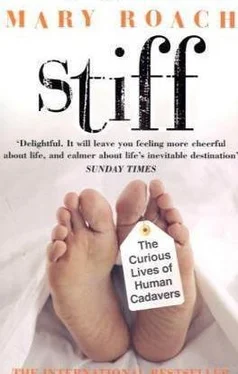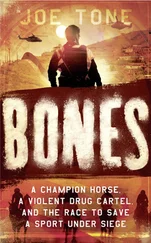Body snatchers were common thugs; their motive, simple greed. But what of the anatomists? Who were these upstanding members of society who could commission the theft and semi-public mutilation of someone’s dead grandmother? The best-known of the London surgeon-anatomists was Sir Astley Cooper. In public, Cooper denounced the resurrectionists, yet he not only sought out and retained their services, but encouraged those in his employ to take up the job. Thing bad.
Cooper was an outspoken defender of human dissection. “He must mangle the living if he has not operated on the dead” was his famous line. While his point is well taken and the medical schools’ plight was a difficult one, a little conscience would have served. Cooper was the type of man who not only evinced no compunction about cutting up strangers’ family members but happily sliced into his own former patients. He kept in touch with the family doctors of those he had operated on and, upon hearing of their passing, commissioned his resurrectionists to unearth them so that he might have a look at how his handiwork had held up. He paid for the retrieval of bodies of colleagues’ patients known to have interesting ailments or anatomical peculiarities. He was a man in whom a healthy passion for biology seemed to have metastasized into a sort of macabre eccentricity. In Things for the Surgeon , an account of body snatching by Hubert Cole, Sir Astley is said to have painted the names of colleagues onto pieces of bone and forced lab dogs to swallow them, so that when the bone was extracted during the dog’s dissection, the colleague’s name would appear in intaglio, the bone around the letters having been eaten away by the dog’s gastric acids. The items were handed out as humorous gifts. Cole doesn’t mention the colleagues’ reactions to the one-of-a-kind name-plates, but I would hazard a guess that the men made an effort to enjoy the joke and displayed the items prominently, at least when Sir Astley came calling. For Sir Astley wasn’t the sort of fellow whose ill will you wanted to take with you to your grave. As Sir Astley himself put it, “I can get anyone.”
Like the resurrectionists, the anatomists were men who had clearly been successful in objectifying, in their own minds at least, the dead human body. Not only did they view dissection and the study of anatomy as justification for unapproved disinterment, they saw no reason to treat the unearthed dead as entities worthy of respect. It didn’t bother them that the corpses would arrive at their doors, to quote Ruth Richardson, “compressed into boxes, packed in sawdust,… trussed up in sacks, roped up like hams…” So similar in their treatment were the dead to ordinary items of commerce that every now and then boxes would be mixed up in transit. James Moores Ball, author of The Sack-’Em-Up Men , tells the tale of the flummoxed anatomist who opened a crate delivered to his lab expecting a cadaver but found instead “a very fine ham, a large cheese, a basket of eggs, and a huge ball of yarn.” One can only imagine the surprise and very special disappointment of the party expecting very fine ham, cheese, eggs, or a huge ball of yarn, who found instead a well-packed but quite dead Englishman.
It wasn’t so much the actual dissecting that smacked of disrespect. It was the whole street-theater-cum-abattoir air of the proceedings. Engravings by Thomas Rowlandson and William Hogarth of eighteenth- and early-nineteenth-century dissecting rooms show cadavers’ intestines hanging like parade streamers off the sides of tables, skulls bobbing in boiling pots, organs strewn on the floor being eaten by dogs. In the background, crowds of men gawk and leer. While the artists were clearly editorializing upon the practice of dissection, written sources suggest the artworks were not far removed from the truth. Here is the composer Hector Berlioz, in an 1822 entry in his Memoirs , shedding considerable light on his decision to pursue music rather than medicine:
Robert… took me for the first time to the dissecting room. …At the sight of that terrible charnel-house—fragments of limbs, the grinning heads and gaping skulls, the bloody quagmire underfoot and the atrocious smell it gave off, the swarms of sparrows wrangling over scraps of lung, the rats in their corner gnawing the bleeding vertebrae—such a feeling of revulsion possessed me that I leapt through the window of the dissecting room and fled for home as though Death and all his hideous train were at my heels.
And I would wager a fine ham and a huge ball of yarn that no anatomist of that era ever held a memorial service for the leftover pieces. Cadaver remainders were buried not out of respect but for lack of other options.
The burials were hastily done, always at night and usually out behind the building.
To avoid the problematic odors that tend to accompany a shallow burial, anatomists came up with some creative solutions to the flesh disposal problem. A persistent rumor had them in cahoots with the keepers of London’s wild animal menageries. Others were said to keep vultures on hand for the task, though if Berlioz is to be believed, the sparrows of the day were well up to the task. Richardson came across a reference to anatomists cooking down human bones and fat into “a substance like Spermaceti,” which they used to make candles and soap. Whether these were used in the anatomists’ homes or given away as gifts was not noted, but between these and the gastric-juice-etched nameplates, it’s safe to say you really didn’t want your name on an anatomist’s Christmas gift list.
And so it went. For nearly a century, the shortage of legally dissectable bodies pitted the anatomist against the private citizen. By and large, it was the poor who had most to lose. For over time, entrepreneurs came up with an arsenal of antiresurrectionist products and services, affordable only by the upper class. Iron cages called mortsafes could be set in concrete above the grave or underground, around the coffin. Churches in Scotland built graveyard “dead houses,” locked buildings where a body could be left to decompose until its structures and organs had disintegrated to the point where they were of no use to anatomists. You could buy patented spring-closure coffins, coffins outfitted with cast-iron corpse straps, double and even triple coffins. Appropriately, the anatomists were among the undertakers’ best customers. Richardson relates that Sir Astley Cooper not only went for the triple coffin option but had the whole absurd Chinese-box affair housed in a hulking stone sarcophagus.
It was an Edinburgh anatomist named Robert Knox who instigated anatomy’s fatal PR blunder: the implicit sanctioning of murder for medicine. In 1828, one of Knox’s assistants answered the door to find a pair of strangers in the courtyard with a cadaver at their feet. This was business as usual for anatomists of the day, and so Knox invited the men in. Perhaps he made them a cup of tea, who knows. Knox was, like Astley, a man of high social bearing. Although the men, William Burke and William Hare, were strangers, he cheerfully bought the body and accepted their story that the cadaver’s relatives had made the body available for sale—though this was, given the public’s abhorrence of dissection, an unlikely scenario.
The body, it turns out, had been a lodger at a boardinghouse run by Hare and his wife, in an Edinburgh slum called Tanner’s Close. The man died in one of Hare’s beds, and, being dead, was unable to come up with the money he owed for the nights he’d stayed. Hare wasn’t one to forgive a debt, so he came up with what he thought to be a fair solution: He and Burke would haul the body to one of those anatomists they’d heard about over at Surgeons’ Square. There they would sell it, kindly giving the lodger the opportunity, in death, to pay off what he’d neglected to in life.
Читать дальше












